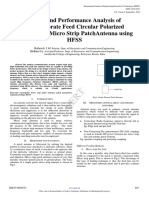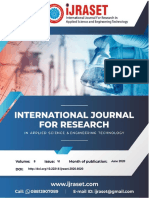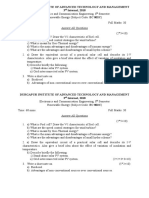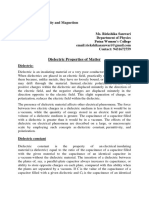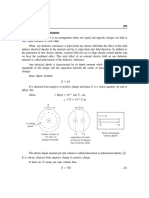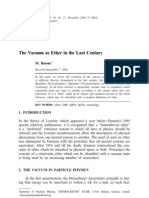Wearable Textile Patch Antenna Using Jeans As Substrate at 2.45 GHZ IJERTV3IS050548
Wearable Textile Patch Antenna Using Jeans As Substrate at 2.45 GHZ IJERTV3IS050548
Uploaded by
aparnaCopyright:
Available Formats
Wearable Textile Patch Antenna Using Jeans As Substrate at 2.45 GHZ IJERTV3IS050548
Wearable Textile Patch Antenna Using Jeans As Substrate at 2.45 GHZ IJERTV3IS050548
Uploaded by
aparnaOriginal Description:
Original Title
Copyright
Available Formats
Share this document
Did you find this document useful?
Is this content inappropriate?
Copyright:
Available Formats
Wearable Textile Patch Antenna Using Jeans As Substrate at 2.45 GHZ IJERTV3IS050548
Wearable Textile Patch Antenna Using Jeans As Substrate at 2.45 GHZ IJERTV3IS050548
Uploaded by
aparnaCopyright:
Available Formats
International Journal of Engineering Research & Technology (IJERT)
ISSN: 2278-0181
Vol. 3 Issue 5, May - 2014
Wearable -Textile Patch Antenna using Jeans as
Substrate at 2.45 GHz
Sweety Purohit Falguni Raval
EC department EC department
CHARUSAT, Changa CHARUSAT, Changa
Gujrat, India Gujrat, India
Abstract—Utilization of wearable textile materials as antenna large if they are to be robust against perturbation by the body.
substrate has been speedy due to the recent miniaturization of However monopole and dipole has no ground plane so there
wireless devices. A wearable antenna is to be a part of the clothing its radiation pattern is effect to the body. So patch antenna is
used for wireless communication purposes, which include tracking preferable.
and navigation, mobile and wearable computing and public safety.
For user convenience there is an increasing need for integrating In general, textiles material has a very low dielectric
antennas on or in the clothing. The conventional antennas are not constant that reduces the surface wave losses and increases the
flexible and difficult for user to movements. There is a need of impedance bandwidth of the antenna. Textile material used
antennas made of flexible textile materials that can be part of user here is jeans; its dielectric constant is 1.6. Here we can make a
clothing defined as wearable antennas. In particular, the micro prototype of partial wearable antenna using self-adhesive
strip patch antennas are good candidates for body-worn copper tape which was tested using scalar network analyzer.
applications, as they mainly radiate perpendicularly to the planar
structure and also their ground plane efficiently shields the body II. DESIGN OF MICROSTRIP PATCH ANTENNA
RT
tissues.[1] This paper shows research on wearable patch antennas
designed and developed for various applications at 2.45 GHz
A. Basic of Patch Antenna
frequency . Here at 2.45 GHz frequency patch antenna is designed In its most fundamental and basic form, a Micro strip Patch
antenna consists of a radiating patch on one side of a dielectric
IJE
and simulated using HFSS.
substrate which has a ground plane on the other side as shown
Keywords — jeans, self adhesive copper tape Wearable in Fig 1[2]. The patch is generally made of conducting
Patch antenna material such as copper silver, or gold and can take any
possible shape like square, rectangular, circular. The radiating
I. INTRODUCTION patch and the feed lines are usually photo etched on the
dielectric substrate.
One of the interesting researches in antennas for body-
centric communications is wearable, textile -based
antennas. Commonly, wearable antenna requires light weight,
low cost, almost maintenance-free and easy installation. There
are number of specialized occupation segments that can
use body centric communication systems, such as medical,
fire fighters, and military. Besides, wearable antennas also can
be applied for patient monitoring, astronauts, and athletes for
the purpose of monitoring
For integration into clothing, antennas are usually required
to be small, lightweight, and flexible. They should have
stability and exhibit safe to person health when placed close to
the body. There are several candidate antenna types suitable
for wearable antennas, which are PIFAs, micro strip antennas,
and planar monopoles. Micro strip antennas are usually
preferred among these options. Micro strip antennas are useful
Figure 1 Rectangular Patch antenna
for on-body wearable communication, because of their ease of
construction, their cost effectiveness. One of the main B. Design of Rectangular Patch Antenna
advantage of patch antenna as wearable application is that its
associated metallic ground plane that when used between the The main factor involved to design a rectangular patch.
body and the radiating elements can significantly reduce the Decide the desire frequency
energy absorbed by the body. However, micro strip antennas
tend to have narrow bandwidth and may need to be relatively Selection of substrate material and height
IJERTV3IS050548 www.ijert.org 2456
International Journal of Engineering Research & Technology (IJERT)
ISSN: 2278-0181
Vol. 3 Issue 5, May - 2014
Design of patch dimension TABLE 1 DIMENSION OF PATCH ANTENNA
Feeding method and its position Desire Parameter Calculated Value
Frequency of patch antenna 2.45 GHz
To design a rectangular patch antenna frequency is 2.45GHz
because it is license free and ISM band so it can use for Dielectric constant 1.6
various application. For wearable patch antenna substrate is Height of Patch antenna 3.5 mm
textile material, here textile material is jeans which has Width of Patch antenna 53.6974 mm
dielectric constant is 1.6. The height of substrate is 3.5mm Length of patch antenna 46.6 mm
because less than 3.5mm it not gives return loss at desire Width of micro stip line 13.1197 mm
level. Dimension of substrate 120mm X 120 mm
C. Calculation of Patch Width Length of inset feed 12.45 mm
The patch width (W) has a minor effect on the resonant
frequency (fr), and it is calculated using the following
According to above calculation following simulated result is
formula (1)
obtained.
Name X Y XY Plot 11 HFSSDesign1 ANSOFT
c 2 0.00 2.4500 -32.5772
m1 Curve Info
w= (1)[3] dB(S(1,1))
2fr (εr + 1)
Setup1 : Sw eep
patchy='46.6mm' sly='12.377mm' sly1='12.377mm' subh='3.5mm' suby='120mm'
-5.00
Where c is the speed of light in free space and εr is the
relative permittivity of the fabric material under test. [3] -10.00
D. Calculation of Effective dielectric constant (εreff) -15.00
dB(S(1,1))
The micro strip patch lies between air and the dielectric Return Loss = -32.5722dB
material, and thus, the EM wave sees an effective permittivity -20.00
(εreff) given by . (2).
-25.00 2.4500GHz
−1 z
𝜀𝑟 + 1 𝜀𝑟 − 1 12ℎ 2
RT
𝜀𝑟eff = + 1+ (2)[3] -30.00
2 2 𝑊 m1
-35.00
1.00 1.50 2.00 2.50 3.00 3.50 4.00
Where h is the thickness of the substrate. Freq [GHz]
IJE
E. Calculation of actual Length of Patch Figure 2 Return loss of antenna
The patch length (L) determines the resonant frequency and it According to simulated result resonat frequency is 2.4 GHz
is a critical parameter in design because of the inherent with S11is- 30 db as shown in fig 2.
narrow bandwidth of the patch. The design value for L is
given by . (3)
𝑐
𝐿= − 2∆𝐿 (3)[3]
2𝑓𝑟 𝜀𝑟eff
Where εreff is the effective permittivity of the material under
test. [3]
F. Calculation of extension length ΔL
At both ends of the patch length, due to the effect of
fringing fields,the extention of length is given by
𝑤
𝜀𝑟𝑒𝑓𝑓 + 0.3 + 0.264
𝛥𝐿 = 0.412ℎ ℎ (4)[3]
𝜀𝑟𝑒𝑓𝑓 − 0.258 𝑤
+ 0.8
ℎ
G. The effective patch length Le
The effective patch length can be calculated
𝐿𝑒 = 𝐿 + 2∆𝐿 5 3
The feeding technique for wearable antenna is inset feeding
because it is easy and comfortable for person to wear the
Figure 3 3-D Radiation pattern of antenna
antenna and fabrication of this feeding is easy.
According to above equation and some optimization the The gain of simulated antenna is 7.26 dB as shown in fig
calculated dimension of antenna is given in table 1. 3. E plane and H plane radiation pattern is shown in fig 4
which is 2-D radiation pattern.
IJERTV3IS050548 www.ijert.org 2457
International Journal of Engineering Research & Technology (IJERT)
ISSN: 2278-0181
Vol. 3 Issue 5, May - 2014
IV. FABRICATED RESULTS AND CRITICAL DESIGN ISSUES
Now after fabrication testing is done using scalar network
analyzer according to test setup as shown in fig 6. According
to tested result return loss is -30dB at 2.492GHz. The
fabricated output result is however similar with the simulated
results. There is minor difference between simulated and
fabricated result because of various reasons which are as
follow.
Figure 4 E and H plane radiation pattern
III. FABRICATION OF TEXTILE PATCH ANTENNA.
For fabrication of prototype textile antenna we have done
following steps
A. Measure the Height of Single layer.
For the desire thickness we have to measure single layer
thickness of substrate material. Measurement of single layer
jeans is done using thickness gauge. It gives the 0.7mm for
single layer.
B. Stack the Jeans for desire height
For the 3.5 mm thickness we have to stack the jeans according Figure 6 Measurement set- up of return loss
to substrate dimension 120 X 120mm stitch it at the edges.
Then remaining jeans was cut using scissor. According to
RT
calculated dimension self-adhesive copper tape which has non
conducting glue is cut using blade. Then using same material
ground plane was cut and stick on jeans substrate.
IJE
C. SMA Connector
Then SMA connector is soldered using normal soldering
techniques. There are chances of burning the jeans material so
special care is taken during soldering.
Figure 7 Practical measured result
A. The height of dielectric substrate.
The dielectric substrate height for patch antenna is taken to be
3.5 mm for jeans material. With this value, we get the
simulation result. However when fabricated, the jeans material
(dielectric substrate) did not give the constant thickness. Being
a fabric material, it has some ups and downs in its surface and
hence is not smooth. When some pressure is applied then its
height is changed. For desire height the jeans is staked. Here 5
layers are used for desire thickness. All the cutting and sewing
are done manually at home so there is some air gap between
the layers and dimension is not as much perfect.
Figure 5 Fabricated wearable patch antenna
B. Dielectric constant of substrate material jeans
The dielectric constant of textile material should be measured
with different techniques like resonance method and non
resonance method with VNA and split post ring resonator, we
considered material has dielectric constant is 1.6 [5].When
IJERTV3IS050548 www.ijert.org 2458
International Journal of Engineering Research & Technology (IJERT)
ISSN: 2278-0181
Vol. 3 Issue 5, May - 2014
fabricating a micro strip patch antenna with solid substrate, the units which limits the use of antenna diversity. On the other
copper is plated on the substrate and the unwanted material is hand antenna diversity can be utilized on a large scale of a
etched out. When fabricating a textile antenna it is required to body worn wireless system [7] .Wearable textile antennas has
attach the radiating patch and ground plane to the dielectric also attracted consumer electronics industry because it fulfills
substrate. This is done by self adhesive copper tape which has the increasing demands from the rapidly evolving wireless
nonconductive glue in between the dielectric substrate and world. Wearable antenna desirable features common to all
radiating patch. When the glue is added in the upper and lower applications require light weight, functional, robust,
layer of the substrate, the dielectric constant of the substrate is unobtrusive, and inexpensive, zero maintenance and no setup
changed and due to this resonance frequency of antenna requirements. The important factors that can influence the
changes because the square root of dielectric constant of the wearable antenna performance are:
substrate is inversely proportional to the frequency. Thus
resonance at lower frequency occurred during measurement A. Human body interaction with the antenna.
which can be seen in S11 plot. When the glue is applied to the The human body is an irregularly shaped medium with
surface of dielectric, the contact between the dielectric frequency dependent permittivity and conductivity [7].The
substrate and the radiating patch becomes non homogeneous. distribution of the electromagnetic field inside the body and
This affects the antenna performance. Between the different the scattered field depends largely on the body physiological
layers of jeans substrate there is some air gap and because of parameters, geometry, frequency and polarization of the
this dielectric constant of air should be changed which incident field. Due to high permittivity of body tissues [6] the
influence the resonant frequency of antenna. antenna resonant frequency will change and detune to a lower
one. [7] Another important parameter is the antenna Gain that
C. Rough Edges of substrate material. directly affects the power transmitted in a maximum radiation
During fabrication, when the textile material is cut to give the direction. Due to human body some part of radiating power of
shape according to the dimensions obtained, a knife and an antenna will be absorbed by it and it will result in lower
scissor was used. Use of this equipment’s introduced two gain, variations in dimensions.[7] Due to stretching and
types of errors. When cutting, due to parallax error, the sides compression which are typical for fabric, the antenna structure
and edges of the radiating element were not straightly cut. can easily deform and affect its performance characteristics.
Because of this, antenna matching is poor. Also when cutting As a result it will be difficult to mass produce an antenna with
the edges of the conductive textile material, some fiber thread the same radiation characteristics even using same materials.
RT
comes out. These threads are on the edges from which the
antenna radiates. This affects the radiation of antenna and B. Water Absorption.
hence the range of antenna decreased when compared with Fabric antennas can easily absorb water and moisture and can
IJE
calculated results. The above mentioned problems can be consequently change the resonant frequency and impedance
solved by taking careful attention and the right tools for the bandwidth of an antenna. Even sweating of wearable person
fabrication. can affect the resonant frequency of antenna.
The fabrication of textile antenna is more complicated than C. SAR Calculation
that of printed antenna. Considering these facts, we were
supposed to fabricate the antenna in an industry with Wearable antenna is used near the body or for on body
appropriate tools and materials, but due to lack of communication for this SAR calculation is needed. The two
commercialization of textile antenna, we had to do it our self. most commonly used SAR limit are those of IEEE1.6W/kg
However this gave us an opportunity to learn more about for any 1g of tissue, and ICNIRP (International Commission
fabrication process and to deal with the problems that arise on Non-Ionizing Radiation Protection [6]) 2W/kg for any 10g
during fabrication process. of tissue. The specific absorption rate (SAR) is an important
parameter to be measured for any wearable antenna design.
This parameter shows the rate of energy absorption by the
V. DESIRABLE FEATURES human body tissue when exposed to fields radiated by the
Wearable antennas have drawn more and more attention in antenna. The SAR is potentially important to any wearable
antenna as they are placed in very close proximity to the body.
recent years due to the fact that they can be seamlessly
There is no specific legislation which considers wearable
integrated into clothing which is a desired feature for hands
devices; however minimization of SAR is a sensible design
free applications and military applications requiring low
goal.
visibility. More importantly wearable antennas can use all the
space on clothing that can be utilized to improve quality of CONCLUSION
signal in wireless communications. Secondly multi path
fading is one of the most severe problems in wireless The micro strip antenna is a suitable candidate for wearable
communication since the signal strength drops as the mobile applications, as it can be built using fabric substrate
terminal moves over a distance comparable to wavelength.[7] materials. Textile material has low dielectric constant
Antenna diversity is a very effective way to combat multipath normally it is 1 to 2. So it can reduce the surface wave losses
fading. However antenna diversity requires at least half a and improve the antenna bandwidth. Here textile antenna
wavelength separation between each antenna in the diversity structures have been tested in order to get preliminary results
system. This is not possible on small form factor hand held on the performance of antennas. The antennas presented
IJERTV3IS050548 www.ijert.org 2459
International Journal of Engineering Research & Technology (IJERT)
ISSN: 2278-0181
Vol. 3 Issue 5, May - 2014
revert versatile, and it is easy to fabricate. According to material different types of antenna can be fabricated. .
simulated results return loss is -32.57 dB at 2.45 GHz and Wearable antenna can be washable if textile material is used
gain is 7.2. Now according to fabrication s11 is -30dB at as substrate and E- textile material is used as ground and
2.4945GHz radiating element then it can be called as fully textile antenna
FUTURE WORK it can be done as future work.
The micro strip antenna is a better candidate for wearable ACKNOWLEDGMENT
applications, as it can be built using textile substrate materials. Special thanks goes to Dr. S Sankaralingam, a senior member
Textile material has low dielectric constant (1 to 2) so it can of, IEEE and full time Research Scholar of Micro strip Patch
reduce the surface wave losses and improve bandwidth of antenna Laboratory, at Jadavpur University, Kolkata, India.
antenna. When moving or doing some physical work, the His knowledge and willingness to help have to facilitate not
antenna may bend. If it is bent, the physical parameter of only my research, but every aspect of my paper work. I
antenna may change and if the physical parameter changes, learned from him the precise attitude to the research and other
the antenna radiation parameter may also change. The antenna works and benefited from his wide knowledge and creative
designed and manufactured in this paper is big in size. The thoughts.
smaller the textile antenna the less it bends. There is various
miniaturization technique for antenna made from copper. The REFERENCES
future work can be to work on the miniaturization of textile
antenna. The miniaturized textile antenna leads to less bending [1] Rita Salvado 1,*, Caroline Loss 1, Ricardo Gonçalves 2 and Pedro
and hence more stable output from the antenna can be Pinho Textile Materials for the Design of Wearable Antennas:A Survey
achieved. Also increasing the radiation efficiency is one of the [2] Hall, P. S., and Hao, Y., “Antennas and Propagation for Body
main challenges for the antenna made from textile material. Centric Communications”, European Conference on Antennas
So this topic can be explored in future studies. Also if and Propagation (EuCAP), November 2006
performance deterioration under wet conditions is to be [3] Balanis, C.A. Antenna Theory: Analysis and Design, 3rd ed.; Wiley
Interscience: Hoboken, NJ,USA, 2005N. H. M. Rais1, P. J. Soh1,
avoided then search needs to be carried out on water proof F.Malek1, S. Ahmad1, N.B.M. Hashim1, P.S Hall2 “A review of
materials for future wearable communication designs. The wearable antenna”
specific absorption rate (SAR) is an important parameter to be [4] S.Sankaralingam, Bhaskar Gupta, Dhar S “Development of Wearable
measured for any antenna design. The SAR is potentially antenna and Implantable antenna in last decade : A review” ; IEEE
RT
Trans Aug.2010
important to any wearable antenna as they are placed in very
[5] S Sankaralingam, Bhaskar Gupta, ,Determination of Dielectric
close proximity to the body. There is no specific legislation Constant of FabricMaterials and Their Use as Substrates for Design
which considers wearable devices; however minimization of andDevelopment of Antennas for Wearable Applications” IEEE
IJE
SAR is a sensible design goal. Because of this reason TRANS. ON INSTRUMENTATION AND MEASUREMENT, VOL. 59,
calculation of SAR characteristics of wearable antennas NO. 12, DECEMBER 2010
designed in research could be carried as future work. In this [6] Federal Communications Commission.
research for radiating and conducting part i.e. for ground and Http://www.fcc.gov/oet/rfsafety/dielectric.html
patch self adhesive copper tape is used so it is called partial [7] Shahid Bashir Doctoral Thesis “Design and Synthesis of Non Uniform
HighImpedance Surface based Wearable Antennas
wearable antenna. Now on days electro-textile material is used
for conductive part. So using electro textile material we can
.
make a fully wearable or textile material. There are different
types of textile material are available in market using these
IJERTV3IS050548 www.ijert.org 2460
You might also like
- Physics of Microwave OvenDocument8 pagesPhysics of Microwave Ovenabdel100% (1)
- Wearable - Textile Patch Antenna Using Jeans As Substrate at 2.45 GHZDocument5 pagesWearable - Textile Patch Antenna Using Jeans As Substrate at 2.45 GHZaparnaNo ratings yet
- Microstrip Loop Antenna For Wearable ApplicationsDocument3 pagesMicrostrip Loop Antenna For Wearable ApplicationsSHIVAM HURKATNo ratings yet
- E Shaped Patch Antennaanalysis IJERTV3IS120861Document4 pagesE Shaped Patch Antennaanalysis IJERTV3IS120861BT20ECE109Nikhil VanjariNo ratings yet
- Design and Performance Analysis of 41 Corporate Feed Circular Polarized Rectangular Micro Strip Patch Antenna Using Hfss IJERTV3IS090767 PDFDocument6 pagesDesign and Performance Analysis of 41 Corporate Feed Circular Polarized Rectangular Micro Strip Patch Antenna Using Hfss IJERTV3IS090767 PDFSuneelkrishna RallabhandiNo ratings yet
- Analysis and Design of Rectangular Microstrip Patch Antenna AT 2.4Ghz WLAN ApplicationsDocument5 pagesAnalysis and Design of Rectangular Microstrip Patch Antenna AT 2.4Ghz WLAN ApplicationsChandra SekharNo ratings yet
- Design and Simulation of Rectangular Microstrip Patch Antenna For C-Band ApplicationsDocument4 pagesDesign and Simulation of Rectangular Microstrip Patch Antenna For C-Band ApplicationsTanko SuleNo ratings yet
- Pre - PH.D Seminar1Document25 pagesPre - PH.D Seminar1Susmitha AradhyaNo ratings yet
- Design of Circular Fractal AntennaDocument4 pagesDesign of Circular Fractal AntennaVidya NeemuNo ratings yet
- 4-Metamaterial-Inspired Widebandbiocompatible Antenna For ImplantableapplicationsDocument7 pages4-Metamaterial-Inspired Widebandbiocompatible Antenna For ImplantableapplicationsYosra BOUCHOUCHANo ratings yet
- Design High Directive Rectangular Microstrip Patch Antenna With SuperstrateDocument8 pagesDesign High Directive Rectangular Microstrip Patch Antenna With SuperstratevenuNo ratings yet
- Design A Rectangular Microstrip Patch Antenna For WLAN ApplicationDocument3 pagesDesign A Rectangular Microstrip Patch Antenna For WLAN ApplicationLalita KumariNo ratings yet
- Microstrip Patch 2x1 Array Antenna With T Slot in Radiating Patch and DGSDocument4 pagesMicrostrip Patch 2x1 Array Antenna With T Slot in Radiating Patch and DGSInternational Journal of Innovative Science and Research TechnologyNo ratings yet
- Microstrip AntennaDocument6 pagesMicrostrip AntennaJournalNX - a Multidisciplinary Peer Reviewed JournalNo ratings yet
- A Review of Various Shapes Microstrip Patch Antenna For High Frequency ApplicationsDocument5 pagesA Review of Various Shapes Microstrip Patch Antenna For High Frequency ApplicationsWaleed SethiNo ratings yet
- Design & Analysis of Square Microstrip Patch AntennaDocument4 pagesDesign & Analysis of Square Microstrip Patch AntennaAnonymous XZUyueNNo ratings yet
- Bansal-Gupta2018 Article AReviewOnMicrostripPatchAntennDocument7 pagesBansal-Gupta2018 Article AReviewOnMicrostripPatchAntennPratikNo ratings yet
- Antenne Pour IoTDocument4 pagesAntenne Pour IoTHamza OthmaniNo ratings yet
- Simulation of Rectangular Patch Antenna With Jeans SubstrateDocument4 pagesSimulation of Rectangular Patch Antenna With Jeans SubstratesugneshhirparaNo ratings yet
- fr4 Covered With JeansDocument10 pagesfr4 Covered With JeansSachin 2003No ratings yet
- L - Probe Fed Microstrip AntennaDocument4 pagesL - Probe Fed Microstrip AntennaUsman QureshiNo ratings yet
- Avinash_Scopus_2018Wearable Antenna for Wireless Applications at 5.3 GHz Frequency-1Document1 pageAvinash_Scopus_2018Wearable Antenna for Wireless Applications at 5.3 GHz Frequency-1Avinash SinghNo ratings yet
- Implantable Compact Patch Antenna For Wireless Body Area Network ApplicationsDocument4 pagesImplantable Compact Patch Antenna For Wireless Body Area Network ApplicationserpublicationNo ratings yet
- Planar Yagi-Uda Antenna With Mirrored Ground Plane For WLANDocument5 pagesPlanar Yagi-Uda Antenna With Mirrored Ground Plane For WLANJBK programNo ratings yet
- (23915439 - Open Engineering) Design & Performance of Wearable Ultra Wide - Band Textile Antenna For Medical ApplicationsDocument7 pages(23915439 - Open Engineering) Design & Performance of Wearable Ultra Wide - Band Textile Antenna For Medical ApplicationsFeby Dwi AnandaNo ratings yet
- A Wearable Self-Grounding Slit Antenna For ISM 4G 5G Bluetooth WLAN ApplicationsDocument8 pagesA Wearable Self-Grounding Slit Antenna For ISM 4G 5G Bluetooth WLAN ApplicationsKanda SamyNo ratings yet
- PatchantennajournalpaperDocument6 pagesPatchantennajournalpaperabdallahmussa199603No ratings yet
- Microstrip Patch Antenna for 2.4GHz Using Slotted Ground PlaneDocument6 pagesMicrostrip Patch Antenna for 2.4GHz Using Slotted Ground Planeprakash110102No ratings yet
- 10 1109@icccnt45670 2019 8944653Document6 pages10 1109@icccnt45670 2019 8944653charanofficialyt27No ratings yet
- Final Report ETE 300 PDFDocument5 pagesFinal Report ETE 300 PDFETE 18No ratings yet
- Vivaldi Paper Mipro19 RevisedDocument6 pagesVivaldi Paper Mipro19 RevisedSoundarya SamSureshNo ratings yet
- Rectangular Microstrip Patch Antenna Design and Simulation For Single S - Band Frequency Using ADSDocument8 pagesRectangular Microstrip Patch Antenna Design and Simulation For Single S - Band Frequency Using ADSMylavarapu SriprithamNo ratings yet
- Design and Characterization of Corporate Feed Rectangular Microstrip Patch Array AntennaDocument6 pagesDesign and Characterization of Corporate Feed Rectangular Microstrip Patch Array AntennaimaculateNo ratings yet
- Design and Simulation of Rectangular Microstrip Patch Antenna For 80 GHZDocument7 pagesDesign and Simulation of Rectangular Microstrip Patch Antenna For 80 GHZIJRASETPublicationsNo ratings yet
- Gopal 2020Document5 pagesGopal 202056947sudhanshujoshiNo ratings yet
- Ijert Ijert: High Gain Yagi-Uda Antenna For High Data Rate Communication SystemDocument3 pagesIjert Ijert: High Gain Yagi-Uda Antenna For High Data Rate Communication SystemOreolNo ratings yet
- Microstrip Antenna Design On Wlan and Dbs Applications: Ritu Lavania, Ashish Duvey, Prasant BadalDocument3 pagesMicrostrip Antenna Design On Wlan and Dbs Applications: Ritu Lavania, Ashish Duvey, Prasant BadalChakradhar AnnepuNo ratings yet
- Final Report ETE 300 PDFDocument5 pagesFinal Report ETE 300 PDFETE 18No ratings yet
- IEEE_Conference_Template (1)Document4 pagesIEEE_Conference_Template (1)jeet.ghosh07No ratings yet
- Wearable AntennaDocument14 pagesWearable AntennaRajesh EceNo ratings yet
- Analysis of Two Inverted F-Shaped Antenna System With Highly Integrated T-Shaped Decoupling StructureDocument6 pagesAnalysis of Two Inverted F-Shaped Antenna System With Highly Integrated T-Shaped Decoupling StructureIJRASETPublicationsNo ratings yet
- Miniaturized Implantable Loop Antenna For Biomedical Applications IJERTCONV5IS13021Document4 pagesMiniaturized Implantable Loop Antenna For Biomedical Applications IJERTCONV5IS13021Pratik GundigaraNo ratings yet
- 22DRDOPaperLakshmiNarayanaDocument6 pages22DRDOPaperLakshmiNarayanaHariniNo ratings yet
- Micro Strip Patch Antenna and Its Applications: A SurveyDocument6 pagesMicro Strip Patch Antenna and Its Applications: A SurveySrishti MisraNo ratings yet
- IEEE_PAPER_JEETDocument4 pagesIEEE_PAPER_JEETjeet.ghosh07No ratings yet
- IJETAE_1113_70Document5 pagesIJETAE_1113_70anajneyulu katuruNo ratings yet
- Design and Analysis of Low Profile and Low SAR Full-Textile UWB WearableDocument12 pagesDesign and Analysis of Low Profile and Low SAR Full-Textile UWB WearableHadi HassanNo ratings yet
- Monopole AntennaDocument3 pagesMonopole AntennaJournalNX - a Multidisciplinary Peer Reviewed JournalNo ratings yet
- Cicn 2014Document6 pagesCicn 2014EfriliaMKhusnaNo ratings yet
- Jurnal Antena MikrostripDocument3 pagesJurnal Antena MikrostriperniNo ratings yet
- IJIRT148524 PAPER VeeruDocument5 pagesIJIRT148524 PAPER VeeruSrishti MisraNo ratings yet
- Final.doc 406Document51 pagesFinal.doc 406Venkata SaiNo ratings yet
- 1495 3051 1 PBDocument10 pages1495 3051 1 PBPar VeenNo ratings yet
- Comparative Analysis of Microstrip Patch Antenna With Different Feeding TechniquesDocument5 pagesComparative Analysis of Microstrip Patch Antenna With Different Feeding TechniquesRadhika SethuNo ratings yet
- Case Study On Microstrip Patch AntennaDocument4 pagesCase Study On Microstrip Patch AntennaVARSHA D ECE-2018-2022No ratings yet
- IEEE_PAPER_JEET (2)Document4 pagesIEEE_PAPER_JEET (2)jeet.ghosh07No ratings yet
- PHASE2Document31 pagesPHASE2kanchanmshinde2000No ratings yet
- Design of Wearable Textile Antenna With Various Substrate and Investigation On Fabric SelectionDocument2 pagesDesign of Wearable Textile Antenna With Various Substrate and Investigation On Fabric SelectionrichamazingNo ratings yet
- IJETR2282Document4 pagesIJETR2282anil kasotNo ratings yet
- Microwave and Millimeter Wave Circuits and Systems: Emerging Design, Technologies and ApplicationsFrom EverandMicrowave and Millimeter Wave Circuits and Systems: Emerging Design, Technologies and ApplicationsNo ratings yet
- Microstrip and Printed Antennas: New Trends, Techniques and ApplicationsFrom EverandMicrostrip and Printed Antennas: New Trends, Techniques and ApplicationsDebatosh GuhaRating: 4 out of 5 stars4/5 (1)
- 5797Document8 pages5797aparnaNo ratings yet
- Booklist 24 25 Class 3Document2 pagesBooklist 24 25 Class 3aparnaNo ratings yet
- Moumita Bose 19-3-04-111. July-Dec Session of 2019: Dr. Aparna Kundu Assistant Professor EceDocument2 pagesMoumita Bose 19-3-04-111. July-Dec Session of 2019: Dr. Aparna Kundu Assistant Professor EceaparnaNo ratings yet
- DR - Aparna Kundu: Certificate of ParticipationDocument1 pageDR - Aparna Kundu: Certificate of ParticipationaparnaNo ratings yet
- HS 758Document26 pagesHS 758aparnaNo ratings yet
- Syllabus Coverage 3rd Yr NewDocument2 pagesSyllabus Coverage 3rd Yr NewaparnaNo ratings yet
- L 4Document13 pagesL 4aparnaNo ratings yet
- Syllabus Coverage 2nd YrDocument2 pagesSyllabus Coverage 2nd YraparnaNo ratings yet
- Antenna Theory & Propagation EC-604A SL No. Slot Duration Module/topic 1 Day 1 1 HourDocument1 pageAntenna Theory & Propagation EC-604A SL No. Slot Duration Module/topic 1 Day 1 1 HouraparnaNo ratings yet
- Printed Antenna Designs Using Defected Ground Structures: A Review of Fundamentals and State-of-the-Art DevelopmentsDocument13 pagesPrinted Antenna Designs Using Defected Ground Structures: A Review of Fundamentals and State-of-the-Art DevelopmentsaparnaNo ratings yet
- Dual-Band Antenna With Compact Radiator For 2.4/5.2/5.8 GHZ Wlan ApplicationsDocument8 pagesDual-Band Antenna With Compact Radiator For 2.4/5.2/5.8 GHZ Wlan ApplicationsaparnaNo ratings yet
- Very Compact Multiband Chip Antenna For Gnss-Wifi-Wimax ApplicationsDocument7 pagesVery Compact Multiband Chip Antenna For Gnss-Wifi-Wimax ApplicationsaparnaNo ratings yet
- Improved Transmission Line Model For Input Impedance of Rectangular Microstrip Antennas With Multi-Dielectric LayersDocument4 pagesImproved Transmission Line Model For Input Impedance of Rectangular Microstrip Antennas With Multi-Dielectric LayersaparnaNo ratings yet
- A Review On Wearable Textile Antenna: December 2015Document6 pagesA Review On Wearable Textile Antenna: December 2015aparnaNo ratings yet
- Design of A Compact Wide Band Microstrip Antenna With Very Low VSWR For Wimax ApplicationsDocument6 pagesDesign of A Compact Wide Band Microstrip Antenna With Very Low VSWR For Wimax ApplicationsaparnaNo ratings yet
- 2 Internal Class Test - Even 2019 Department: - ECE - Semester: - 8 - Subject Name: Renewable Energy - Subject Code: - EC802CDocument1 page2 Internal Class Test - Even 2019 Department: - ECE - Semester: - 8 - Subject Name: Renewable Energy - Subject Code: - EC802CaparnaNo ratings yet
- Promotion2 TKDocument1 pagePromotion2 TKaparnaNo ratings yet
- Subject: Appeal For Upgradation of DesignationDocument1 pageSubject: Appeal For Upgradation of DesignationaparnaNo ratings yet
- Ec 802CDocument2 pagesEc 802CaparnaNo ratings yet
- Q1Document18 pagesQ1aparnaNo ratings yet
- Digital FIR Filter Design Using Evolutionary OptimizationDocument2 pagesDigital FIR Filter Design Using Evolutionary OptimizationaparnaNo ratings yet
- OCR 1 TerjemahanDocument10 pagesOCR 1 TerjemahanDwiNo ratings yet
- Xii Stud Iit - Ic - FTM-03 - 05.06.2023 - QPDocument19 pagesXii Stud Iit - Ic - FTM-03 - 05.06.2023 - QPDinesh BabuNo ratings yet
- QB Emt 2024Document5 pagesQB Emt 2024lekoringoeNo ratings yet
- The Modeling and SOC Estimation of A LiFePO4 BatteDocument17 pagesThe Modeling and SOC Estimation of A LiFePO4 Batteabner.paulaNo ratings yet
- Cdlecture Lecture3Document25 pagesCdlecture Lecture3Nur Ezzah MalikNo ratings yet
- Electrostatic Potential and CapacitanceDocument21 pagesElectrostatic Potential and CapacitanceJintu DekaNo ratings yet
- Revised First Term Examination-Schedule and Portion 2023-2024 ISC Std. 12 Date: 1 August 23 Date Subject Portion Drama - The TempestDocument47 pagesRevised First Term Examination-Schedule and Portion 2023-2024 ISC Std. 12 Date: 1 August 23 Date Subject Portion Drama - The Tempestyuvrajkeswani06No ratings yet
- 8-InVALCO-BS&W Presentation Ron CombsDocument22 pages8-InVALCO-BS&W Presentation Ron Combsjairo beltranNo ratings yet
- An Approach To Increase Data Transmission Capacity in Coaxial Cable Communication SystemDocument94 pagesAn Approach To Increase Data Transmission Capacity in Coaxial Cable Communication SystemKhalif ElnaddabNo ratings yet
- JEE Main Electrostatics Practice Paper With Solutions Download PDFDocument19 pagesJEE Main Electrostatics Practice Paper With Solutions Download PDFkandanmani05971No ratings yet
- Electrical and Mechanical Properties of Banana Fiber Reinforced Polyester CompositesDocument161 pagesElectrical and Mechanical Properties of Banana Fiber Reinforced Polyester CompositesAnandNo ratings yet
- Engineering Materials PHY110 Unit VIDocument67 pagesEngineering Materials PHY110 Unit VIKundan KumarNo ratings yet
- DPP Nomex410 K20612-1Document6 pagesDPP Nomex410 K20612-1Hemant LimayeNo ratings yet
- Utilization of Electric Power: Heating and WeldingDocument29 pagesUtilization of Electric Power: Heating and WeldingNokhwrang BrahmaNo ratings yet
- On The Use of Vias in Conductor-Backed Coplanar CircuitsDocument7 pagesOn The Use of Vias in Conductor-Backed Coplanar CircuitsDenz ChoeNo ratings yet
- Dielectric Properties of MatterDocument11 pagesDielectric Properties of MatterTanima DeyNo ratings yet
- Module 2: Resistive, Capacitive & Inductive Transducer: Resistance PotentiometerDocument38 pagesModule 2: Resistive, Capacitive & Inductive Transducer: Resistance PotentiometerSAKSHI CHIKSHENo ratings yet
- Dielectric MaterialsDocument45 pagesDielectric MaterialsBhavya TanneruNo ratings yet
- Unacademy CapacitanceDocument39 pagesUnacademy CapacitanceMayank TripathiNo ratings yet
- Barnett, S J - On The Cavendish Experiment and The Law of Inverse Squares in ElectrostaticsDocument3 pagesBarnett, S J - On The Cavendish Experiment and The Law of Inverse Squares in ElectrostaticsVITOR DOLIWANo ratings yet
- Nr-40 Multiferroics MaterialsZSurowiakDBochenekDocument49 pagesNr-40 Multiferroics MaterialsZSurowiakDBochenekSmitha KollerahithluNo ratings yet
- Dipole Moment and PolarizationDocument3 pagesDipole Moment and PolarizationNitish DubeyNo ratings yet
- Time Domain Polarisation Measurements With The Sawyer-Tower MethodDocument4 pagesTime Domain Polarisation Measurements With The Sawyer-Tower MethodRakesh SandarativjuNo ratings yet
- Electrical Field Tests For The Life Management of TransformersDocument207 pagesElectrical Field Tests For The Life Management of TransformersCaribNo ratings yet
- Electric Fields in Material SpaceDocument144 pagesElectric Fields in Material Spacefranklinreypacquiao100% (1)
- LEP 4.2.06 Dielectric Constant of Different Materials: Related Topics ProblemsDocument4 pagesLEP 4.2.06 Dielectric Constant of Different Materials: Related Topics ProblemsgauravniralaNo ratings yet
- SMPTE 379M MXF Generic ContainerDocument14 pagesSMPTE 379M MXF Generic Containernarebi6213No ratings yet
- M. Barone - The Vacuum As Ether in The Last CenturyDocument10 pagesM. Barone - The Vacuum As Ether in The Last CenturyOppekeeNo ratings yet
- R20 21 Course Strcture and Syllabus ECEDocument37 pagesR20 21 Course Strcture and Syllabus ECEemoNo ratings yet




